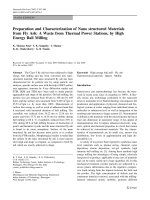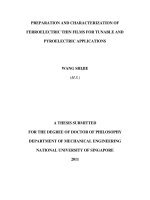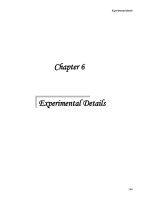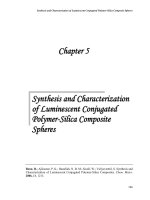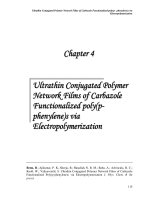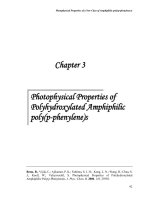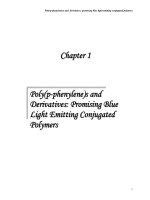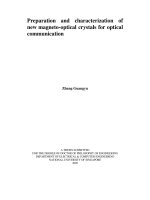Preparation and characterization of Co(II) ion-imprinted composite membrane based on a novel functional monomer
Bạn đang xem bản rút gọn của tài liệu. Xem và tải ngay bản đầy đủ của tài liệu tại đây (9.95 MB, 13 trang )
Microporous and Mesoporous Materials 334 (2022) 111707
Contents lists available at ScienceDirect
Microporous and Mesoporous Materials
journal homepage: www.elsevier.com/locate/micromeso
Preparation and characterization of Co(II) ion-imprinted composite
membrane based on a novel functional monomer
Li Zhao b, 1, Deqiong Hu a, c, 1, Huiling Cheng a, *
a
Faculty of Science, Kunming University of Science and Technology, Kunming, Yunnan, 650500, China
Faculty of Land Resource Engineering, Kunming University of Science and Technology, Kunming, Yunnan, 650051, China
c
Yunnan Chihong Resources Comprehensive Utilization Co. Ltd, Qujing, Yunnan, 655000, China
b
A R T I C L E I N F O
A B S T R A C T
Keywords:
Novel functional monomer
Ion-imprinted composite membrane
Membrane selectivity permeation
Cobalt
In this paper, a novel functional monomer, N-(pyrrolidin-2-ylmethyl) methacrylamide (PMMA), was synthesized.
Using Co(II) ions as the template, 2,2-azoisobutyronitrile (AIBN) as the initiator, ethylene glycol dimethacrylate
(EDGMA) as the crosslinking agent, twenty-seven Co(II) ion-imprinted composite membranes (Co(II)-PMMAIICM1~27) and their corresponding non-imprinted composite membranes (PMMA-NICM1~27) were prepared.
Additionally, the related parameters of the imprinting system were systematically optimized. Co(II) ionimprinted composite membranes (Co(II)-PMMA-IICM16) were prepared using Nylon-6 as the supporting mem
brane, which was soaked in a pre-polymerized solution of N,N-dimethylformamide and water (DMF: H2O (v/v) =
1: 1) for 180 s, using a molar ratio of template, monomer, and crosslinker of 1: 4: 50. The obtained material had a
higher adsorption capacity (Qe = 428.24 mg g− 1) and imprinting factor (IF = 2.36). The surface and internal
porosity of Co(II)-PMMA-IICM16 were characterized by scanning electron microscopy and a nitrogen adsorption
apparatus. In addition, it was found that the adsorption process of Co(II)-PMMA-IICM16 prepared under optimal
conditions was better described by a Langmuir isotherm adsorption model, which verified that the adsorption
involved monolayer adsorption. The kinetics data was more closely fit by a pseudo-second-order kinetics model,
indicating that this adsorption process proceeded via chemisorption. The permeation experiments indicated that
a “delayed” permeation mass transfer mechanism also occurred (β(Co(II)/Cd(II)) = 2.11 and β(Co(II)/Cu(II)) = 1.55).
The Co(II) ion-imprinted composite membrane prepared in this paper demonstrated a relatively better imprinting
effect, a specific recognition ability for template ions, and good selective permeability. These results validated
that the design of this novel functional monomer was reasonable, and that it has potential applications in various
fields where adsorption is necessary.
1. Introduction
Cobalt (Co) is a naturally occurring heavy metal that exists in three
oxidation states (0, +2, and +3), the most of which is +2. Co(II) is highly
susceptible to corrosion by alkali, water, and air, and as a result, it has
been widely used in various applications including electroplating,
mineral processing, and forging [1,2]. Along with economic develop
ment and social progress, significant amounts of Co(II) have been
released into the environment. At low levels, Co(II) ion acts as a nutrient
and has benefits for both humans and plants [3]. In contrast, beyond
permissible levels, it may lead to various acute or chronic reactions such
as those affecting the gastrointestinal tract, asthma, pneumonia and so
on [4–6]. Therefore, the effective treatment and removal of Co(II) ions
from wastewater is still highly important.
Ion imprinting technology is derived from molecular imprinting
technology, which is also a biomimetic recognition technology that can
introduce ion recognition sites into some polymeric materials [7–10].
Ion-imprinted polymers prepared by ion imprinting have high affinities
and selectivity for template ions [11]. Membrane separation technology
is one of the most promising separation techniques due to its many
advantages such as continuous operation, easy amplification, and low
energy consumption. However, current commercially-available ultra
filtration, microfiltration, and reverse osmosis membranes lack pre
determined selectivity, and it is difficult to achieve the selective
* Corresponding author.
E-mail address: (H. Cheng).
1
These authors contributed to the work equally and should be regarded as co-first authors.
/>Received 18 December 2021; Received in revised form 11 January 2022; Accepted 14 January 2022
Available online 24 January 2022
1387-1811/© 2022 The Authors.
Published by Elsevier Inc.
This is an open
( />
access
article
under
the
CC
BY-NC-ND
license
L. Zhao et al.
Microporous and Mesoporous Materials 334 (2022) 111707
separation of individual substances [12,13]. Membranes prepared via a
combination of ion imprinting techniques allow for the simple, fast, and
effective separation of specific ions.
Ion-imprinted composite membranes (IICMs) are comprised of an
ion-imprinted polymer layer on either the surface or pores of an existing
membrane, which combines the advantages of an ion-imprinted poly
mer with the stability of a membrane. The recognition ability of IICMs is
closely related to the properties of the complexes formed between
template ions and functional monomers. Therefore, selecting functional
monomers that match the functional groups and structures of template
ions is the key to preparing IICMs with good performance [14–17].
Suitable functional monomers can be selected according to the structure
of the template ions. Acidic template ions can be selected for basic
functional monomers, and mixed functional monomers can also be
considered for some complex template ions. Acrylic acid, acrylamide,
and vinyl pyridine are the mostly common functional monomers used to
prepare IICMs [18–23]. However, these functional monomers and
template ions only weakly bind to each other, so it is difficult to use them
for ion imprinting. Therefore, much research has focused on designing
new functional monomers which possess strong ionic bonding abilities
with the template ions for ion imprinting. In recent years, some studies
have reported the development of novel functional monomers. For
example, Betra et al. [24] synthesized a novel polymerizable functional
monomer containing three functional groups, which was then poly
merized with styrene to prepare a molecular-imprinted polymer mem
brane which selectively recognized imprinted molecules. Fang et al.
[25] designed and synthesized a heterocyclic compound containing a
positively-charged imidazole moiety, tetra-bromine-bi-4,5-2 (methylene
bi-imidazole) acridine. This compound was used as a functional mono
mer, antimony potassium tartrate as a template, and bulk polymeriza
tion was used to successfully prepare a novel Sb(III)-ion-imprinted
polymer (CFM-IIP). Xu et al. [26] synthesized thymine-isocyanate trie
thoxysilane (T-IPTS) as a functional monomer to successfully prepare
mercury-imprinted polymers capable of specifically recognizing mer
cury ions. Some studies have made progress by synthesizing novel
functional monomers with different target ions, as well as analyzing the
feasibility, recognition mechanism, and new characterization methods.
Additionally, identifying and pioneering a new research field using
novel functional monomers for ion imprinting has promising prospects.
In this paper, an absorbent material, Co(II) ion-imprinted composite
membranes (Co(II)-PMMA-IICMs) was prepared by Co(II) ion as the
template, N-(pyrrolidin-2-ylmethyl) methacrylamide (PMMA) as the
novel function monomer, a commercial membrane as the support
membrane. Additionally, the related parameters of the influence factors
were systematically optimized. The surface morphology, internal
structure, adsorption characteristics, and mass transfer mechanism of
the optimal imprinted composite membrane were studied. The results
showed that the membrane had good specific adsorption recognition
and permeation selectivity for Co(II) template ions, and it is expected
that the membrane can be used for the removal of Co(II) from aqueous
solutions.
methacrylamide (PMMA) is detailed in the Supplementary Materials
Document.
Ultraviolet–visible spectrophotometry (UV–Vis) (UV-2500, Shi
madzu, Japan) was used to obtain the UV–Vis spectra of Co(II)-IICMs
and NICMs. An N2 adsorption apparatus (MFA-140, Builder) and scan
ning electron microscopy (SEM, Nova Nano SEM 450FEI-IMC, USA)
were employed to characterize the surface area and porosity of Co(II)IICMs and NICMs, respectively. Inductively coupled plasma optical
emission spectroscopy (ICP-OES) (Avio 500, PerkinElmer, America) was
used to analyze the concentration of metal ions.
2.2. Synthesis of N-(pyrrolidin-2-ylmethyl) methacrylamide
The synthetic method of N-(pyrrolidin-2-ylmethyl) methacrylamide
is shown in Fig. 1, whose steps are detailed below.
A mixture of N-Boc prolinol 1 (10.05 g, 50 mmol) and anhydrous
potassium carbonate (6.9 g, 50 mmol) was formed in a round bottom
flask, and anhydrous dichloromethane (150 mL) was used to dissolve the
mixture. P-toluene sulfonyl chloride (11.5 g, 60 mmol) was added to the
mixed solution in batches, and the reaction was carried out for 24 h.
Once the TLC indicated the disappearance of the reagents, the reaction
solution was poured into cold water (200 mL) and stirred for 30 min, and
the methylene chloride layer was washed three times with water (50 mL
× 3). After drying with anhydrous sodium sulfate, the organic phase was
concentrated in vacuo, and compound 2 was obtained without additional
purification.
Compound 2 and sodium azide (6.5 g, 100 mmol) were dissolved in
dry DMF in an oil bath at 92 ◦ C, and the reaction was allowed to proceed
for 24 h. After the reaction was completed, the mixture was cooled to
room temperature and dissolved in ethyl acetate (200 mL). Then, after
washing the organic layer 3 times with water and drying and concen
trating with anhydrous sodium sulfate, compound 3 was obtained.
Compound 3 and palladium on carbon (0.1 g) were dissolved in
methanol (100 mL) and allowed to react at room temperature under a
hydrogen atmosphere for 2 days. After the TLC indicated the disap
pearance of the reactants, the solution was filtered, and compound 4 was
obtained.
Next, anhydrous dichloromethane (100 mL) was used to dissolve a
mixture of anhydrous potassium carbonate (6.9 g, 50 mmol) and
methacryloyl chloride (5 mL) with magnetic stirring in an ice bath. The
dichloromethane solution containing compound 4 was added into the
mixture, and the reaction was allowed to proceed overnight. Once the
TLC indicated the disappearance of the raw materials, the reaction
mixture was poured into cold water (200 mL) and stirred for 1 h. Then,
the methylene chloride layer was washed three times with water (50 mL
× 3). After drying with anhydrous sodium sulfate, the organic phase was
concentrated in vacuo, and compound 5 was obtained.
Finally, anhydrous dichloromethane (30 mL) was used to dissolve a
mixture of compound 5 and trifluoroacetate (20 mL), and the reaction
proceeded for 24 h. After the TLC indicated the consumption of reagents,
saturated sodium carbonate solution was slowly added dropwise to the
mixture until no more gas evolution was observed. Then, the solution
was stirred for 1 h, and dichloromethane (50 mL × 3) was used to extract
the solution. After drying with anhydrous sodium sulfate, the organic
phase was concentrated in vacuo. Light-green oily compounds (3.19 g)
were obtained by column chromatography using dichloromethane as the
eluent. The total yield of the five-step sequence was 38%.
The intermediates involved in the synthesis process were reported
according to Refs. [27,28], and final product N-(pyrrolidin-2-ylmethyl)
methacrylamide was characterized as follows:
1
H NMR (400 MHz, CDCl3, ppm) δ: 5.21 (s, 1H), 5.10 (s, 1H), 4.96
(brs, 1H), 4.17 (d, J = 7.3 Hz, 1H), 3.55–3.63 (m, 3H), 3.35–3.41 (m,
1H), 2.07 (d, J = 5.2 Hz, 1H), 1.90 (s, 3H), 1.85 (d, J = 6.0 Hz, 2H),
1.70–1.74 (m, 1H), 1.51–1.60 (m, 1H); 13C NMR (100 MHz, CDCl3, ppm)
δ: 173.09, 141.33, 116.67, 66.95, 60.99, 50.20, 28.42, 24.78, 19.77.
2. Experimental
2.1. Materials and instruments
Analytically pure reagents used in this experiment, including cobalt
chloride hexahydrate (CoCl2⋅6H2O), were purchased from Fangchuan
Chemical Reagent Technology (Tianjin, China). Ethylene glycol dime
thacrylate (EDGMA), 2,2-azoisobutyronitrile (AIBN), NaOH, HCl, and
CH3CH2COOH were purchased from Aladdin Industrial Corporation
(Shanghai, China) and used as received. Polyvinylidene fluoride (PVDF),
Nylon-6, and polytetrafluoroethylene membrane (PTFE), with pore sizes
of 0.45 μm and thicknesses of 125 μm, were obtained from Shanghai
Yadong Heji Rosin Co., Ltd, (Shanghai, China) and used to produce
adsorbent. The synthetic procedure of N-(pyrrolidin-2-ylmethyl)
2
L. Zhao et al.
Microporous and Mesoporous Materials 334 (2022) 111707
Fig. 1. Synthetic method of N-(pyrrolidin-2-ylmethyl) methacrylamide.
2.3. Preparation of Co(II) ion-imprinted composite membrane
room temperature. After 12 h, the solution was analyzed by UV–Vis to
determine the concentration of Co(II) ions.
The adsorption capacity Q (mg.g− 1) of Co(II)-PMMA-IICM16 and
PMMA-NICM16 and the imprinting factor IF at equilibrium were calcu
lated by the following equations:
Co(II)-PMMA-IICM were prepared according to the procedure shown
in Fig. 2. The detailed procedure is as follows:
First, 0.0238 g CoCl2⋅6H2O and different amounts of functional
monomer N-(pyrrolidin-2-ylmethyl) methacrylamide (PMMA) were
mixed and dissolved in solvents, and then shocked for 3 h at 25 ◦ C. Then,
the crosslinker, ethylene glycol dimethacrylate (EGDMA), and 10.00 mg
initiator, 2,2-azoisobutyronitrile (AIBN), were added into this mixture.
After being ultrasonicated for 5 min, a pre-polymerization complex was
formed. Next, different support membranes were soaked in a prepolymerization solution for a certain period of time at room tempera
ture. The polymerization was carried out for about 24 h at 60 ◦ C. Finally,
the obtained Co(II)-PMMA-IICM were washed by a mixture of methanol
and acetic acid in a volume ratio of 9: 1. The as-prepared membranes
were dried for 24 h after the template ions were completely removed
using Soxhlet extraction.
Non-imprinted composite membranes (PMMA-NICM) were prepared
according to the abovementioned method, but the template (CoCl2.
6H2O) was absent.
(1)
Q = (C0 − C).V / m
IF = QCo(II)−
/
PMMA− IICM
QPMMA−
NICM
(2)
where C0 and C (mg.mL− 1) are the initial and equilibrium concentra
tions of the Co(II) ions, respectively, V (mL) is the volume of the solu
tion, and m is the mass of the Co(II)-PMMA-IICM16.
2.4.1. Adsorption isotherms
The adsorption behavior of Co(II)-PMMA-IICM16 was described by
the Langmuir and Freundlich models:
2.4. Batch adsorption experiments
Langmuir ⋅
model:⋅C/Q = KL /qm + C/qm
(3)
Freundlich ⋅
model:⋅lnQ = lnC/n + lnKF
(4)
where Q (mg⋅g− 1) is the amount of Co(II) ions on Co(II)-PMMA-IICM16
at equilibrium, C (mg⋅mL− 1) is the concentration of the Co(II) ions at
equilibrium, qm (mg⋅g− 1) is the maximum adsorption capacity, KL
(mL⋅mg− 1) and KF (mg⋅g− 1) represent the equilibrium constants of the
First, 20.0 mg Co(II)-PMMA-IICM16 and 10.00 mL Co(II) solution
with a fixed initial concentration were added into a stoppered 25.00 mL
Erlenmeyer flask. Then, the flask containing Co(II) ions was shocked at
Fig. 2. Schematic of the preparation process of Co(II)-PMMA-IICM.
3
L. Zhao et al.
Microporous and Mesoporous Materials 334 (2022) 111707
Langmuir and the Freundlich models, respectively.
the left cell, and an identical volume of deionized water was placed into
the right cell. Then, competitive penetration experiments were carried
out using a mechanical stirrer with a fixed speed at 25 ◦ C. The amount of
metal ions in the receiving solution was determined via ICP-OES.
The permeation flux J (mg⋅cm− 2 s− 1), permeability coefficient P
(cm2⋅s− 1), and permeation selectivity factor β were obtained from the
following equations:
2.4.2. Adsorption kinetics
Pseudo-first-order and pseudo-second-order kinetic models were
used to study the adsorption kinetics of Co(II) on Co(II)-PMMA-IICM16,
as shown in equations (5) and (6):
Pseudo − first − order ⋅ kinetic ⋅
model: ⋅ ln(Q − Qt ) = − k1 t + lnQ
(5)
Pseudo − second − order ⋅ kinetic⋅
/
/
/
model:⋅t Qt = t Q + Q2 k2
(6)
− 1
where Qe (mg⋅g ) is obtained from the abovementioned contents, Qt
(mg⋅g− 1) is the amount of Co(II) adsorbed at time t, K1 (min− 1) and K2
(g⋅mg− 1⋅min− 1) are the rate constants of the pseudo-first-order, and
pseudo-second-order kinetic models.
(7)
ΔGθ = ΔH θ − TΔSθ
(8)
/
/
lnK = − ΔH RT + ΔSθ R
(9)
θ
/
/
ln(Q / C) = ΔSθ R − ΔH θ RT
(11)
P = Ji d/(CFi − CRi )
(12)
/
βCo2+ /j = PCo2+ Pj ⋅j = ⋅Cu(II)⋅or⋅Cd(II)
(13)
where A (cm2), d (cm), and V (mL) represent the effective membrane
area, membrane thickness, and the volume of the feeding and receiving
solutions, respectively. ∇Ci/∇t represents the changes in the concen
trations in the receiving solution, and CFi and CRi are the corresponding
ion concentrations in the feeding and receiving pools, respectively.
2.4.3. Adsorption thermodynamics
The thermodynamic parameters, including the enthalpy change
(ΔHθ ), Gibbs free energy change (ΔGθ ), and entropy change (ΔSθ ), were
calculated by using the following Van’t Hoff expressions:
ΔGθ = − RT lnKd
Ji = ΔCi V/ΔtA⋅i = Co(II), ⋅Cu(II), ⋅or⋅Cd(II)
3. Results and discussion
3.1. Effects of various parameters during the preparation of Co(II)PMMA-IICM
3.1.1. Effects of support membrane species
The properties of the supporting membrane are one of the important
factors affecting the selectivity and permeability of ion-imprinted
composite membranes. To obtain a better Co(II)-PMMA-IICM, a series
of (Co(II)-PMMA-IICM1~3) and corresponding non-imprinted mem
branes (PMMA-NICM1~3) were prepared using polytetrafluoroethylene
(PTFE), polyvinylidene fluoride (PVDF), and Nylon-6 microfiltration
membranes. The properties of these composites were tested using Co(II)
solutions.
It can be seen from Fig. 4 that the Co(II)-PMMA-IICM3 had a better
adsorption capacity (692.89 mg g− 1) than PMMA-NICM3, and its
imprinting factor (IF) reached 1.24. This may be due to the fact that the
Nylon-6 membranes are more hydrophilic than the PTFE and PVDF
membranes. That is, the Nylon-6 membrane pores were more easily
filled with solvent and solute molecules because they were more easily
adsorbed onto the membranes, which increased the adsorption capacity
of the Nylon-6 membrane [29]. Therefore, the following experiments
used Nylon-6 as the support membrane.
(10)
where R (8.314 J mol− 1 K− 1) is the universal gas constant, T (K) is the
absolute temperature, and Kd is the thermodynamic equilibrium
constant.
2.5. Permeation experiments
Competitive penetration tests were used to test the selective
permeation performance of Co(II)-PMMA-IICM16. First, Co(II)-PMMAIICM16 was fixed on an H-shaped permeation device (Fig. 3), with a total
volume of 200 mL and an area of 1.5 cm2 at the joint of the two cells.
Then, 100.00 mL of an aqueous solution containing Co(II), Cd(II), and
Cu(II) ions with identical concentrations of 25 mg mL− 1 was added into
3.1.2. Effects of functional monomer dosages
To investigate the effect of functional monomer dose during poly
merization on Co(II)-PMMA-IICMs, several Co(II)-PMMA-IICM3~6 were
fabricated using template-to-monomer ratios of 1:2, 1:4, 1:6, and 1:8 to
identify the appropriate ratio. As shown in Fig. 5, when too little or too
much was used, the adsorption of the Co(II)-PMMA-IICMs depended on
the amount of functional monomer due to the specific recognition ability
of the imprinted membrane majority. When an insufficient amount of
functional monomer was used, it is difficult to form stable complexes
with imprinted ions. In contrast, excessive functional monomer can
produce many non-specific binding sites in the membrane, which can
reduce the recognition ability and selectivity of the membrane [30,31].
According to the imprinting factor and adsorption capacity of the
imprinted composite membranes, the optimal amount of functional
monomer was 4 mmol. Therefore, the molar ratio of the template ion to
functional monomer was 1:4.
3.1.3. Effects of the amount of cross-linker
Effects of the amount of cross-linker (EGDMA) on the adsorption
capacity was also investigated. The crosslinking agent is the main
component in ion-imprinted composite membranes and can fix
template-monomer complexes in the polymer matrix. The amount of
Fig. 3. Schematic of the H-Shape permeation device.
4
L. Zhao et al.
Microporous and Mesoporous Materials 334 (2022) 111707
Fig. 4. The adsorption capacity of support membrane species.
(mCo(II)-PMMA-IICM = 20 mg; CCo(II) = 25 mg mL− 1; t = 12 h; pH = 7; T = 25 ◦ C).
Fig. 5. The adsorption capacity of functional monomer dosages.
(mCo(II)-PMMA-IICM = 20 mg; CCo(II) = 25 mg mL− 1; t = 12 h; pH = 7; T = 25 ◦ C).
crosslinking agent can also affect the structural integrity, accessibility,
and quantity of recognition sites, thereby changing the mesh structure
and adsorption properties of composite membranes [32]. Fig. 6 shows
the adsorption capacity of Co(II)-IICM3,7~12 and NICM3,7~12 prepared
from different molar ratios of template ions and crosslinking agents
(1:10, 1:20, 1:30, 1:40, 1:50, 1:60, and 1:70, respectively).
Fig. 6 shows that the maximum amount of adsorbed Co(II) ion
(625.84 mg g− 1) was obtained when using Co(II)-PMMA-IICM12 pre
pared with a 1:50 M ratio of Co(II) ion to EGDMA. This material had a
better imprinting factor (1.40). If too little crosslinking agent was used,
the template-monomer chelate structure did not form during prepolymerization, Moreover, the lack of a crosslinking agent was not
helpful for forming imprinted sites [33], which gave the imprinted
composite membrane a poor selectivity. However, the use of excessive
crosslinking agent increased the rigidity of the membrane, and made the
substrate close to the imprinting site. As a result, a template: functional
monomer: crosslinker ratio of 1:4:50 was selected to prepare the Co
(II)-PMMA-IICM.
5
L. Zhao et al.
Microporous and Mesoporous Materials 334 (2022) 111707
Fig. 6. The adsorption capacity of amount of cross-linker.
(mCo(II)-PMMA-IICM = 20 mg; CCo(II) = 25 mg mL− 1; t = 12 h; pH = 7; T = 25 ◦ C).
3.1.4. Effects of solvent ratio
Co(II) ions are water-soluble, while cross-linking agents and func
tional monomers are hydrophobic. To maintain the binding spaces of Co
(II) ions during polymerization, the imprinting process requires a ho
mogenous mixture of Co(II) ions, functional monomers, and crosslinking agents. Therefore, the pore-forming solvent must be mixed
with water and an organic solvent [34]. In this work, organic solvents
(CH3OH, CH3CH2OH, (CH3)2CHOH, and CH3CH2CN) and H2O at a
volume ratio of 1:1 (v/v) were used. Additionally, different volume ra
tios of N, N-dimethylformamide (DMF) and H2O (1:1, 1:3, 2:3, 3:1, 3:2,
3:7, 7:3) were used during preparation.
The results in Table 1 show that the optimal solvent composition was
1:1 (v/v) DMF:H2O, and the experiment achieved a better imprinting
factor of 2.36 using Co(II)-PMMA-IICM16 (428.24 mg g− 1), compared
with PMMA-NICM16 (181.68 mg g− 1). The influence of solvent
composition on the imprinting factor was greater than that on the
adsorption amount. The imprinting factor is used as the main means to
evaluate adsorption. Therefore, Co(II)-PMMA-IICMs using an optimum
volume ratio (v/v) of DMF:H2O 1:1 was used in the following
experiments.
3.1.5. Effects of soaking time on membrane
In the pre-polymerization system, a short soaking time was not
favorable for the deposition of the imprinted polymer, making it difficult
for the membrane to be covered. However, excessive soaking times
resulted in the formation of thick imprinted polymer deposits on the
composite membrane. Under these conditions, it is difficult for the
substrate to access the recognition sites in the imprinted membrane
interior, which is not conducive to the adsorption and recognition of the
substrate by the membrane [35]. Therefore, soaking times of 30 s, 60 s,
180 s, 360 s, 1800 s, and 3600 s were selected for the study, as shown in
Fig. 7.
It is evident from Fig. 7 that the adsorption ability of Co(II) ions
increased with soaking times less than 180 s The better adsorption ca
pacity of Co(II)-PMMA-IICM16 and PMMA-NICM16 were 428.24 and
181.68 mg g− 1 separately, and the imprinting factor is calculated to be
2.36 from these two values. After 180 s, the adsorption of Co(II) ions
decreased to 324.42 mg g− 1. The ion-imprinted composite membrane
showed the best affinity and specific recognition to Co(II) ions when the
base membrane was soaked for 180 s.
The optimized Co(II)-PMMA-IICM16 had a relatively good adsorption
capacity and high imprinting factor when the following preparation
conditions were used: a Nylon-6 microporous membrane as the sup
porting membrane, a solvent volume ratio of 1:1 (v/v) of DMF: H2O, a
molar ratio of template ions, functional monomer, and cross-linker of
1:4:50, and a membrane soaking time of 180 s.
Table 1
The adsorption capacity of various solvent ratios. (mCo(II)-PMMA-IICM = 20 mg; CCo
− 1
◦
(II) = 25 mg mL ; t = 12 h; pH = 7; T = 25 C).
Membrane
Solvent ratio (v:v)
Q (Co(II)-PMMA-IICM)
(mg.g− 1)
Q (PMMA-NICM)
(mg.g− 1)
IF
12
13
CH3OH: H2O (1: 1)
CH3CH2OH: H2O (1:
1)
(CH3)2CHOH: H2O
(1: 1)
CH3CH2CN: H2O (1:
1)
DMF: H2O (1: 1)
DMF: H2O (1: 3)
DMF: H2O (2: 3)
DMF: H2O (3: 1)
DMF: H2O (3: 2)
DMF: H2O (3: 7)
DMF: H2O (7: 3)
625.84
672.34
447.03
560.29
1.40
1.20
689.66
538.79
1.28
512.40
413.22
1.24
428.24
639.48
344.46
243.75
301.17
379.30
251.89
181.68
586.94
268.24
233.98
229.26
292.92
179.46
2.36
1.09
1.28
1.04
1.31
1.29
1.40
14
15
16
17
18
19
20
21
22
3.2. Characterization
3.2.1. SEM
The surface topographies of Nylon-6, Co(II)-PMMA-IICM16, and
PMMA-NICM16 were obtained using SEM (Fig. 8), and indicate that the
surface morphology and pore structures of Co(II)-PMMA-IICM16 and
PMMA-NICM16 were different than the Nylon-6 membrane. The surface
of the Nylon-6 base membrane (Fig. 8a) exhibited a symmetrical and flat
network structure compared with Co(II)-PMMA-IICM16 (Fig. 8b). The
corresponding surface of PMMA-NICM16 (Fig. 8c) appears rough, indi
cating that the surfaces of the base membranes of Co(II)-PMMA-IICM16
and PMMA-NICM16 were coated with a thin polymer layer.
6
L. Zhao et al.
Microporous and Mesoporous Materials 334 (2022) 111707
Fig. 7. The adsorption capacity as a function of membrane soaking time.
(mCo(II)-PMMA-IICM = 20 mg; CCo(II) = 25 mg mL− 1; t = 12 h; pH = 7; T = 25 ◦ C).
Fig. 8. SEM images of the surfaces of Nylon-6(a), Co(II)-PMMA-IICM16 (b), and PMMA-NICM16 (c).
It was also clearly shown that Co(II)-PMMA-IICM16 (Fig. 8b) had a
greater pore diameter than PMMA-NICM16 (Fig. 8c), which can be
attributed to the influence in the membrane surface area and pore
structure during imprinting. Ion-imprinted cavities were located at the
surface and inside Co(II)-PMMA-IICM16, and these cavities can match
the size and function of imprinted molecules. Furthermore, these results
are consistent with those obtained in adsorption experiments.
NICM16 were obviously different.
As summarized in Table 2, all related parameters of Co(II)-PMMAIICM16 and PMMA-NICM16 were displayed, including the specific sur
face area and average pore diameter which values are distributed at
9.019, 9.660 m2 g− 1 and 11.768, 10.518 nm, respectively. It can be
inferred that both Co(II)-PMMA-IICM16 and PMMA-NICM16 belong to
mesoporous material according to pore diameter, the Co(II)-PMMAIICM16 is higher than PMMA-NICM16 between two kinds of value. Large
surface area can provide more recognition sites to facilitate cobalt
adsorption, and the pore sizes of the materials further demonstrate that
there is a “template effect” in Co(II)-PMMA-IICM16.
3.2.2. BET
To determine the effect of the template (Co(II) ions) during prepa
ration and Co(II) adsorption ability, Co(II)-PMMA-IICM16 and PMMANICM16 were subjected to BET analysis, which is depicted in Fig. 9a and
b, respectively. Both the pore diameter distributions and surface areas
were tested. The results shown in Fig. 9, according to the IUPAC clas
sification method, show that Co(II)-PMMA-IICM16 and PMMA-NICM16
were a type IV isotherms and typical mesoporous materials. In addition,
the slopes of the adsorption-desorption isotherms of Co(II)-PMMAIICM16 and PMMA-NICM16 were significantly different, indicating that
the membrane pore structure of Co(II)-PMMA-IICM16 and PMMA-
3.3. Adsorption isotherms
The Co(II) adsorption capacity using Co(II)-PMMA-IICM16 and
PMMA-NICM16 with an initial concentration range of 5–30 mg mL− 1
was studied at a pH of 7. The results are shown in Fig. 10. The adsorption
capacities of Co(II)-PMMA-IICM16 and PMMA-NICM16 gradually
increased as the initial concentration of Co(II) ions increased. As the
7
L. Zhao et al.
Microporous and Mesoporous Materials 334 (2022) 111707
Fig. 9. The N2 adsorption-desorption isotherms of Co(II)-PMMA-IICM16 (a) and PMMA-NICM16 (b) (insets are the pore diameter distributions).
relatively higher than PMMA-NICM16 because PMMA-NICM16 may not
have had any cavities which matched the Co(II) ions. The PMMANICM16 could adsorb Co(II) ions to some extent, but not selectively. Co
(II)-PMMA-IICM16 contains many cavities which match the shape and
size of Co(II) ions, and these cavities could specifically recognize and
memorize Co(II) ions. Thus, the adsorption capacity of PMMA-NICM16
was lower than Co(II)-PMMA-IICM16.
The data was fitted as 1/Ce versus 1/Qe and lnCe versus lnQe to study
the Langmuir and Freundlich models, respectively, the results are shown
in Fig. 11a and b. KL, qm, n, and KF were calculated using the slope and
intercept of the correlation lines, and the results are summarized in
Fig. 11. The linear correlation coefficient (R2) of the plot of the
Freundlich model was relatively better than the Langmuir model, which
indicates that the adsorption process was closer to a Freundlich model.
Table 2
The corresponding parameters of Co(II)-PMMA-IICM16 and PMMA-NICM16.
Material
Surface area
(m2.g− 1)
Pore volume
(cm3.g− 1)
Average pore
diameter (nm)
Co(II)-PMMAIICM16
PMMA-PMMANICM16
9.660
0.032
11.768
9.019
0.031
10.518
initial concentration of Co(II) increased, the mass transfer driving force
between the solution and the membrane increased, which increased the
adsorption capacity.
Additionally, the adsorption ability of Co(II)-PMMA-IICM16 was
Fig. 10. Effect of initial Co(II) concentration on the adsorption capacity of Co(II)-PMMA-IICM16.
8
L. Zhao et al.
Microporous and Mesoporous Materials 334 (2022) 111707
Fig. 11. The Langmuir model (a) and Freundlich model (b) for the adsorption of the Co(II) ions on the Co(II)-PMMA-IICM16.
This suggests that adsorption may have occurred through a multilayer
adsorption process.
NICM16. This may be due to the fact that the initial adsorption included
adsorption by surface imprinted pores. As the adsorption time increased,
the surface imprinted pores became saturated. When the imprinted ions
were transferred into the membrane interior, the resistance increased,
which decreased the adsorption rate. Finally, the adsorption amount
slowly increased and finally reached equilibrium, but there were no
pores which corresponded to the template ion structure in PMMANICM16. The adsorption was mainly affected by the non-specific
adsorption of the surface non-imprinted composite membrane, and so
adsorption equilibrium was quickly reached.
Plots of t versus log (Qe-Qt) for the Co(II) ions adsorption kinetics
behavior are shown in Fig. 13a, and the constants of Co(II)-PMMAIICM16 and PMMA-NICM16 were calculated from the correlation line.
3.4. Adsorption kinetics
The residence times of the adsorbate at the solid-solution interface
and solute adsorption rate were determined using kinetics models using
data obtained from experiments performed between 5 and 180 min.
Fig. 12 shows that the adsorption rate of Co(II)-PMMA-IICM16 and the
corresponding PMMA-NICM16 rapidly increased within 30 min, and the
adsorption amount of Co(II)-PMMA-IICM16 increased much more
rapidly than PMMA-NICM16. Finally, the adsorption amount tended to
reach equilibrium at 45 min using Co(II)-PMMA-IICM16 and PMMA-
Fig. 12. Kinetic adsorption curves of Co(II)-PMMA-IICM16 and PMMA-NICM16.
9
L. Zhao et al.
Microporous and Mesoporous Materials 334 (2022) 111707
Fig. 13. The pseudo-first-order (a) and pseudo-second-order (b) kinetic models of Co(II)-PMMA-IICM16 and PMMA-NICM16.
The linear correlation coefficients (R2) of these plots were relatively
worse.
Plots of t versus t/Qt for the Co(II) ions adsorption kinetic behavior
are shown in Fig. 13b. Compared with the plots in Fig. 13a, the linear
correlation (R2) demonstrated that a pseudo-first-order kinetics model
was not as good as the pseudo-second-order kinetics model. The rate
constant K2 for Co(II)-PMMA-IICM16 and PMMA-NICM16 were 0.0024
and 0.0027 g mg⋅min− 1, respectively, which may be due to diffusion
resistance of the Co(II) ions to functional monomers [36].
The above data indicate that the entire adsorption process of Co(II)
ions on Co(II)-PMMA-IICM16 and PMMA-NICM16 was mainly controlled
by chemical adsorption. In other words, the adsorption capacity of ad
sorbents was proportional to the number of active sites on their surface,
and chemisorption may be the rate-limiting step in the overall adsorp
tion process.
3.6. Effects of pH during Co(II) adsorption
The adsorption process was significantly affected by the pH of
aqueous solution, which can affect the protonation of the amino group
and the degree of ionization of the adsorbate. The effects of the pH value
of Co(II) ion solution on Co(II)-PMMA-IICM16 adsorption were studied
and discussed in this section, and the results are shown in Fig. 14.
When the pH increased from 3 to 7, the amount of adsorbed Co(II)
increased from 312.56 mg g− 1 to 359.47 mg g− 1, and reached a
maximum value (359.47 mg g− 1) when the pH was 7. Further increasing
the pH caused the adsorption amount to decrease to 348.49 mg g− 1. The
reason for the initial increase followed by the decrease may be that the
amino group was protonated [38], which affected the surface
morphology of Co(II)-PMMA-IICM16.
3.7. Permeation selectivity of membranes
3.5. Adsorption thermodynamics
Permeation selectivity experiments provided a key understanding of
the relationship between the template imprinting sites and arrangement
of functional groups. According to the various ways of transferring
imprinting ions in the membrane, the mass transfer mechanisms of the
imprinted membrane can be classified as either “promoting” or
“delaying” permeation [39]. Due to the presence of a concentration
gradient, imprinted ions and other ions spread in the same direction
during the promoting permeation process. In this process, the imprinted
ions are preferentially adsorbed onto the holes with specific recognition
abilities, which can slow down other ion penetration rates and promote
the mass transfer of target ions. Moreover, during delayed permeation,
the specific recognition holes interact with target ions to reach satura
tion, but other ions which do not interact with the recognition sites can
diffuse to the other side of the membrane.
The permeation selectivity of the Co(II)-PMMA-IICM16, which pos
sesses the optimal adsorption capacity and imprinting factor, was
studied and discussed in this part. Co(II), Cd(II), and Cu(II) ions were
add to the feeding solution at identical concentrations, and the results
are shown in Table 4. The permeation flux J of Co(II), Cd(II) and Cu(II)
ions on Co(II)-PMMA-IICM16 reached 4.09 × 10− 5, 8.39 × 10− 5 and
66.25 × 10− 5 mg cm− 2 s− 1, respectively. Additionally, the permeability
coefficient P of Co(II), Cd(II), and Cu(II) ions reached 7.57 × 10− 10, 1.60
× 10− 9 and 1.17 × 10− 9 cm2 s− 1, respectively. The transmittance of Co
(II) ions was significantly lower than Cu(II) and Cd(II) ions, possibly
because the holes on the Co(II)-PMMA-IICM16 interacted with the Co(II)
To study the effects of temperature on the adsorption amounts of the
Co(II)-PMMA-IICM16, experiments were carried out between 15 and
55 ◦ C. The adsorption thermodynamics were studied by calculating
several parameters. From Table 3, it can be seen that the value of ΔGθ
was negative, indicating that the adsorption of Co(II) on the Co(II)PMMA-IICM16 was a spontaneous process. The values of ΔHθ and ΔSθ
were − 5288 J mol− 1 and 3.574 J mol− 1 K− 1, respectively. The negative
value of ΔHθ indicates that the adsorption reaction was exothermic.
Therefore, a higher temperature hindered the adsorption of Co(II) ions
on Co(II)-PMMA-IICM16. The positive values of ΔSθ indicate that the
randomness of the solid/dissolved interface increased during adsorption
[37].
Table 3
The thermodynamics model parameters.
T (K)
ΔGθ (J⋅mol− 1)
263
273
283
293
303
−
−
−
−
−
6228
6264
6299
6335
6371
ΔHθ (J⋅mol− 1)
ΔSθ (J⋅mol− 1⋅K− 1)
− 5288
3.574
10
L. Zhao et al.
Microporous and Mesoporous Materials 334 (2022) 111707
Fig. 14. Effect of pH on the adsorption capacity of Co(II)-PMMA-IICM16.
Table 4
The permeation selectivity of Co(II), Cd(II), and Cu(II) ions through Co(II)PMMA-IICM16.
Membranes
Co(II)-PMMAIICM16
Substrates
Co(II) ions
2
J (mg cm−
s− 1)
4.09 × 10−
5
− 5
Cd(II) ions
8.39 × 10
Cu(II) ions
6.25 × 10−
5
P (cm2 s− 1)
7.57 ×
10− 10
1.60 ×
10− 9
1.17 ×
10− 9
β Co/
β
Cd
Cu
2.11
1.55
Co/
ions until adsorption reached saturation. In contrast, Cd(II) and Cu(II)
ions did not interact with the recognition sites and diffused to the other
side of Co(II)-PMMA-IICM16. Therefore, the penetration of Co(II) ions
through Co(II)-PMMA-IICM16 follows a “delayed” permeation mass
transfer mechanism, and demonstrates that there is indeed a hole in Co
(II)-PMMA-IICM16 that selectively binds to the template ions, giving rise
to selective permeability.
Fig. 15. Regeneration testing of Co(II)-PMMA-IICM16.
3.8. Regeneration testing
imprinted composite membranes (Co(II)-PMMA-IICMs) to selectively
adsorb Co(II) ions. Co(II)-PMMA-IICM16 was prepared which showed a
high Co(II) adsorption capacity (428.24 mg g− 1) and imprinting factor
(2.36). The material was prepared in a pre-polymerized solution of DMF:
H2O (v/v) 1:1 for 180 s via thermal initiation with AIBN, Nylon-6 as the
supporting membrane, and a molar ratio of template (Co(II) ions),
functional monomer (N-(pyrrolidin-2-ylmethyl) methacrylamide), and
cross-linker (EDGMA) of 1:4:50.
The batch adsorption experiments indicated that the initial adsorp
tion of Co(II) ions was relatively fast, and the absorption process reached
equilibrium within only 45 min. The adsorption kinetics were fit to a
pseudo-second-order reaction kinetics model, and the adsorption iso
therms for Co(II) were closer to a Freundlich model, suggesting that the
adsorption may proceed via monolayer adsorption.
The permeation selectivity experiments indicated that Co(II)-PMMAIICM16 could selectively recognize imprinted Co(II) ions. The
Recycling properties is extremely vital for adsorbed materials,
especially in the treatment of actual samples, excellent performance can
not only save production costs but also maximize profits to a certain
extent. For investigating the regeneration ability of Co(II)-PMMAIICM16, a set of testing were conducted. As Fig. 15 displayed, after four
cycles of using, it still has good adsorption performance, and the
adsorption rate only decreases by 16.6%, in addition, it can also be seen
that the membrane of loading Co(II) is easier to elute target ion. In
summary, Co(II)-PMMA-IICM16 exhibit high adsorption rate and
regeneration for Co(II) which expected to be used for the treatment of
cobalt in actual sewage.
4. Conclusions
In this study, a novel functional monomer, N-(pyrrolidin-2-ylmethyl)
methacrylamide, was synthesized and used to fabricate Co(II) ion11
L. Zhao et al.
Microporous and Mesoporous Materials 334 (2022) 111707
permeation selectivity factors (β) of Co(II)-PMMA-IICM16 for Co(II) ions
was 2.11 and 1.55 for Cd(II) ions and Cu(II) ions, respectively, showing
that Co(II)-PMMA-IICM could be used to selectively recognize and
adsorb Co(II) ions. The effective adsorption ability of Co(II)-PMMA-IICM
verified that Co(II)-PMMA-IICM is a promising material for the selective
adsorption of Co(II) ions from aqueous solutions.
[15]
[16]
[17]
CRediT authorship contribution statement
Li Zhao: Methodology, Project administration, Data curation,
Writing – original draft. Deqiong Hu: Writing – original draft, Writing –
review & editing, Software. Huiling Cheng: Supervision.
[18]
[19]
Declaration of competing interest
[20]
The authors declare that they have no known competing financial
interests or personal relationships that could have appeared to influence
the work reported in this paper.
[21]
Acknowledgements
[22]
This work was financially supported by the Natural Science Foun
dation of China (no. 21764008 and 51674128).
[23]
References
[24]
[1] F.S.K.A.H. Esmaeili, Synthesis of CaO/Fe3O4 magnetic composite for the removal
of Pb(II) and Co(II) from synthetic wastewater [J], Journal of Serbian Chemistry
Society 83 (2) (2018) 237–249, />[2] M.K. Uddin, A review on the adsorption of heavy metals by clay minerals, with
special focus on the past decade [J], Chem. Eng. J. 308 (2017) 438–462, https://
doi.org/10.1016/j.cej.2016.09.029.
[3] A. Dyer, J. Newton, M. Pillinger, Synthesis and characterisation of mesoporous
silica phases containing heteroatoms, and their cation exchange properties. Part 3.
Measurement of distribution coefficients for uptake of 137-Cs, 89-Sr and 57-Co
radioisotopes [J], Microporous Mesoporous Mater. 130 (1–3) (2010) 56–62,
/>[4] N. Khoddami, F. Shemirani, A new magnetic ion-imprinted polymer as a highly
selective sorbent for determination of cobalt in biological and environmental
samples [J], Talanta 146 (2016) 244–252, />talanta.2015.08.046.
[5] W. Luo, Z. Bai, Y. Zhu, Fast removal of Co(ii) from aqueous solution using porous
carboxymethyl chitosan beads and its adsorption mechanism [J], RSC Adv. 8 (24)
(2018) 13370–13387, />[6] M. Torkashvand, M.B. Gholivand, R. Azizi, Synthesis, characterization and
application of a novel ion-imprinted polymer based voltammetric sensor for
selective extraction and trace determination of cobalt (II) ions [J], Sensor.
Actuator. B Chem. 243 (2017) 283–291, />snb.2016.11.094.
[7] J. Park, H.A. Dam, D. Kim, Selective sorption behavior of metal(II) ion-imprinted
polymethacrylate microspheres synthesized via precipitation polymerization
method [J], Kor. J. Chem. Eng. 32 (5) (2015) 967–973, />s11814-014-0374-y.
[8] Q. Feng, D. Wu, Y. Zhao, et al., Electrospun AOPAN/RC blend nanofiber membrane
for efficient removal of heavy metal ions from water [J], J. Hazard Mater. 344
(2018) 819–828, />[9] M.R. Awual, M. Ismael, T. Yaita, Efficient detection and extraction of cobalt(II)
from lithium ion batteries and wastewater by novel composite adsorbent [J],
Sensor. Actuator. B Chem. 191 (2014) 9–18, />snb.2013.09.076.
[10] C. Cui, M. He, B. Chen, et al., Restricted accessed material-copper(II) ion imprinted
polymer solid phase extraction combined with inductively coupled plasma-optical
emission spectrometry for the determination of free Cu(II) in urine and serum
samples [J], Talanta 116 (2013) 1040–1046, />talanta.2013.08.027.
[11] A. Diouf, N. El Bari, B. Bouchikhi, A novel electrochemical sensor based on ion
imprinted polymer and gold nanomaterials for nitrite ion analysis in exhaled
breath condensate [J], Talanta 209 (2020) 120577, />talanta.2019.120577.
[12] S.F. Kamarudin, M.N. Ahmad, I.H. Mohamed Dzahir, et al., Development of
quercetin imprinted membranes-based PVDF substrate [J], Polym. Bull. 76 (8)
(2018) 4313–4334, />[13] D. Sun, Y. Zhu, M. Meng, et al., Fabrication of highly selective ion imprinted
macroporous membranes with crown ether for targeted separation of lithium ion
[J], Separ. Purif. Technol. 175 (2017) 19–26, />seppur.2016.11.029.
[14] Z. Wang, D. Kong, N. Qiao, et al., Facile preparation of novel layer-by-layer surface
ion-imprinted composite membrane for separation of Cu2+ from aqueous solution
[25]
[26]
[27]
[28]
[29]
[30]
[31]
[32]
[33]
[34]
[35]
[36]
[37]
12
[J], Appl. Surf. Sci. 457 (2018) 981–990, />apsusc.2018.07.031.
H. Cheng, X. Zhu, S. Yang, et al., A pH-controllable imprinted composite membrane
for selective separation of podophyllotoxin and its analog [J], J. Appl. Polym. Sci.
128 (1) (2013) 363–370, />X. Deng, C. Chen, J. Xie, et al., Selective adsorption of elastase by surface molecular
imprinting materials prepared with novel monomer [J], RSC Adv. 6 (49) (2016)
43223–43227, />˙
L. Trzonkowska, B. Le´sniewska, B. Godlewska-Zyłkiewicz,
Studies on the effect of
functional monomer and porogen on the properties of ion imprinted polymers
based on Cr(III)-1,10-phenanthroline complex designed for selective removal of Cr
(III) ions [J], React. Funct. Polym. 117 (2017) 131–139, />j.reactfunctpolym.2017.04.006.
K.L. Hickenbottom, T.Y. Cath, Sustainable operation of membrane distillation for
enhancement of mineral recovery from hypersaline solutions [J], J. Membr. Sci.
454 (2014) 426–435, />J.P. Mericq, S. Laborie, C. Cabassud, Vacuum membrane distillation of seawater
reverse osmosis brines [J], Water Res. 44 (18) (2010) 5260–5273, />10.1016/j.watres.2010.06.052.
A. Baghel, M. Boopathi, B. Singh, et al., Synthesis and characterization of metal ion
imprinted nano-porous polymer for the selective recognition of copper [J], Biosens.
Bioelectron. 22 (12) (2007) 3326–3334, />bios.2007.01.016.
H.-G. Wu, X.-J. Ju, R. Xie, et al., A novel ion-imprinted hydrogel for recognition of
potassium ions with rapid response [J], Polym. Adv. Technol. 22 (9) (2011)
1389–1394, />Y. Oren, E. Korngold, N. Daltrophe, et al., Pilot studies on high recovery BWROEDR for near zero liquid discharge approach [J], Desalination 261 (3) (2010)
321–330, />H. Ebrahimzadeh, M. Behbahani, A novel lead imprinted polymer as the selective
solid phase for extraction and trace detection of lead ions by flame atomic
absorption spectrophotometry: synthesis, characterization and analytical
application [J], Arab. J. Chem. 10 (2017) S2499–S2508, />j.arabjc.2013.09.017.
D.B.A.K.J. Shea, Novel trifunctional building blocks for fluorescent polymers [J],
Org. Lett. 5 (21) (2003) 3895–3898.
L. Fang, X. Xiao, R. Kang, et al., Highly selective adsorption of antimonite by novel
imprinted polymer with microdomain confinement effect [J], J. Chem. Eng. Data
63 (5) (2018) 1513–1523, />S. Xu, L. Chen, J. Li, et al., Novel Hg2+-imprinted polymers based on thymine-Hg2
+-thymine interaction for highly selective preconcentration of Hg2+ in water
samples [J], J. Hazard Mater. 237–238 (2012) 347–354, />j.jhazmat.2012.08.058.
A.S.A.E. Yeheskiely, Full PaperA novel N-(Pyrrolidinyl-2-methyl)glycine-Based
PNA with a strong preference for RNA over DNA [J], 2002, Eur. J. Org Chem. (14)
(2002) 2391–2399, />AID-EJOC2391>3.0.CO;2-D.
N. Dahlin, A. BøGEVIG, H. Adolfsson, N-Arenesulfonyl-2-aminomethylpyrrolidines
novel modular ligands and organocatalysts for asymmetric catalysis [J], Adv.
Synth. Catal. 346 (910) (2004) 1101–1105, />adsc.200404098.
D. Qiu, Study on the preparation and property of coumarin molecularly imprinted
composite membranes [J], J. Yunnan Univ. 36 (1) (2014) 101–107, https://doi.
org/10.7540/j.ynu.20130447.
K.H.A.K. Mosbach, Plastic antibodies: developments and applications [J], TIBTECH
NOVEMBER 16 (11) (1998) 468–475, />01198-6.
Q. Li, B. Ling, L. Jiang, et al., A paradigm shift design of functional monomers for
developing molecularly imprinted polymers [J], Chem. Eng. J. 350 (2018)
217–224, />S. Gam-Derouich, M. Jouini, D. Ben Hassen-Chehimi, et al., Aryl diazonium salt
surface chemistry and graft photopolymerization for the preparation of
molecularly imprinted polymer biomimetic sensor layers [J], Electrochim. Acta 73
(2012) 45–52, />H. Bai, C. Xiong, C. Wang, et al., Electrochemical sensor based on Rh(III) ionimprinted polymer as a new modifying agent for rhodium determination [J],
J. Nanosci. Nanotechnol. 18 (5) (2018) 3577–3584, />jnn.2018.14667.
C.H. Su-Qiong, Preparation of molecularly imprinted polymer with racemic
tyrosine and study on its recognition properties [J], Chemical Research and
Application 28 (12) (2016) 1704–1711.
H.-S. Choi, Y.-H. Oh, C.-H. Ryu, et al., Characteristics of the all-vanadium redox
flow battery using anion exchange membrane [J], J. Taiwan Inst. Chem. Eng. 45
(6) (2014) 2920–2925, />X. Luo, L. Liu, F. Deng, et al., Novel ion-imprinted polymer using crown ether as a
functional monomer for selective removal of Pb(ii) ions in real environmental
water samples [J], J. Mater. Chem. 1 (28) (2013), />c3ta11098b.
G.S. Subramanyan Vasudevan, Ravichandran Subbiah, Jayaraj Jeganathan,
Lakshmi Jothinathan, Sheela Sagayaraj Margrat, Studies on the removal of
L. Zhao et al.
Microporous and Mesoporous Materials 334 (2022) 111707
phosphate from drinking water by electrocoagulation process [J], Ind. Eng. Chem.
Res. 47 (6) (2008) 2018–2023, />[38] R.S. Shao, Effect of pH on competitive adsorption of Cu(II), Ni(II), and Zn(II) from
water onto chitosan beads [J], Adsorption 8 (1) (2002) 71–78, />10.1023/A:1015222607996.
[39] W.W. Viktor Kochkodan, Molecularly imprinted composite membranes for
selective binding of desmetryn from aqueous solutions [J], Desalination 149 (1–3)
(2002) 323–328, />
13

